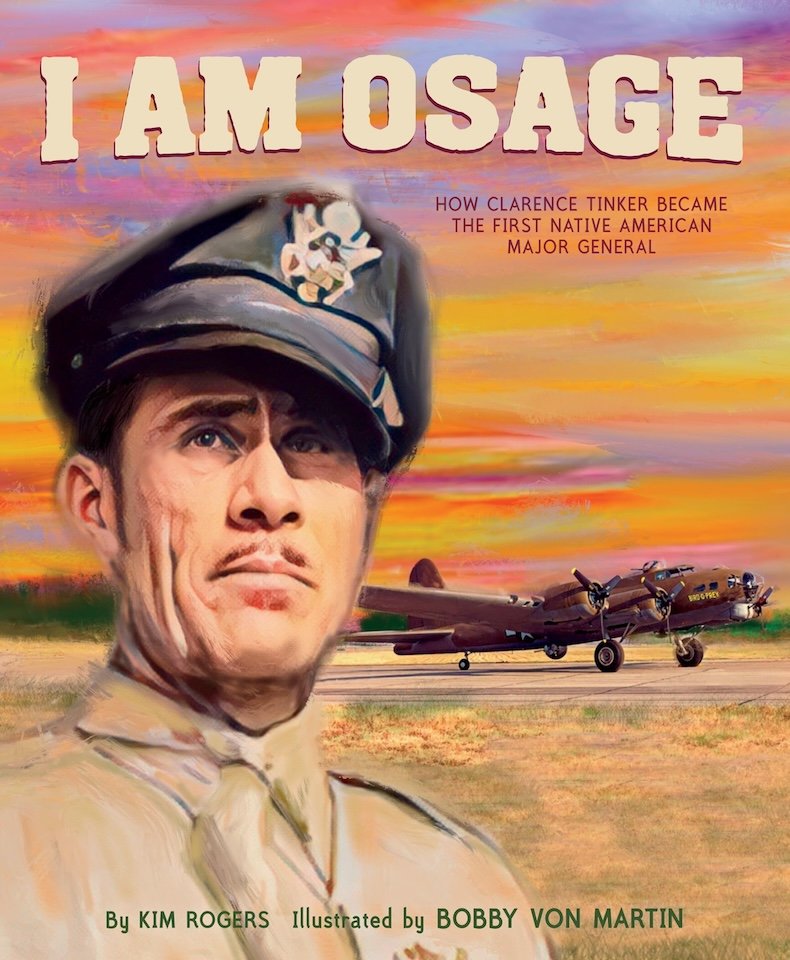Process Talk with Jen: Kim Rogers on I Am Osage
[Posted by Jen Breach for Writing With a Broken Tusk]
Kim Rogers (Wichita and Affiliated Tribes) comes from a military family. Many of her family members served at Tinker Air Force Base in Oklahoma, named for Clarence Tinker, the first Native American Major General in the US Military, and the subject of Kim’s recent picture book biography I Am Osage.
Photo courtesy of Kim Rogers
Finding Clarence’s story was a surprise to Kim–she stumbled across a record of him in the Oklahoma Historical Society while researching something else entirely–and the process of writing the biography was likewise unexpected.
[Jen] Kim, in an interview with AJ Eversole at Cynsations, you said “Writing this book changed me,” and your author’s note speaks full-heartedly and plainly about intergenerational trauma from colonization and forced assimilation. Can you talk a little about the place/s, if any, your personal journey touched the way you approached Clarence’s story?
[Kim] I was able to relate to General Tinker because many of us Natives share a similar story—one of survival, determination, and resilience in the face of evil and heartache. Like my own ancestors, he was taken from his family as a child and forced to attend Indian boarding school where they tried to erase his culture and make him ashamed of who he was. I found much inspiration in General Tinker because he stood against it by continuing to speak his Osage language and holding tight to his Osage roots. It made me think about my own family and how it felt to be Native when I was growing up. He showed himself to be a citizen of the Osage Nation during a time when it was not looked upon favorably. He pushed back against that. I found such inspiration and strength in his story. It set me on a path of healing. I am grateful for General Tinker.
[Jen] You have also said that you re-wrote the manuscript for I am Osage “too many times to count.” What did that drafting look like?
[Kim] The changes were minor to extensive with each draft. Every manuscript either had a different throughline, changes to the text, and/or both. I printed up each version to reread and added it to a towering stack that I didn’t want to shred yet—for reference in case I missed some hidden gems. But none of it felt right, so I stepped away for a bit. Then one day after I stopped piling so much pressure on myself, I thought about what made General Tinker the success that he was. The title came to me and everything clicked. It was so simple!
The title I Am Osage could work for any Native nation including my own—insert whatever nation you come from. I am Wichita. I thought about all the things that made me proud of my own Native heritage. This thought process connected me even more to General Tinker.
To me, writing is a gut feeling endeavor. When I realized the title, I knew then that I was finally on the right path. That’s one of the things that I love about writing a book—that “aha moment” when everything comes together after struggling with it for so long. Yes, the writing struggle is real! Figuring out the difficult parts and finally finding what works, makes the journey worthwhile.
[Jen] Such truth and wisdom! Perhaps relatedly, choosing the scope for a true story is often a tricky business for nonfiction writers. And Clarence’s story is rich with detail and important context. How did you come to settle on the scope of this story? And when or how did you know you had done enough research (whatever that “enough” might mean!)?
[Kim] I had written many of what I call “skeleton” versions of General Tinker’s story—this is my own personal way of outlining. I do a lot of that on the page. I wrote different life events that supported each throughline. When I figured out the title, I Am Osage, I was able to write another skeleton version and then fill in the rich and emotional details.
I love research so much. It’s fulfilling for me to learn about a fascinating figure in history. Even more fulfilling is to learn about a Native American unsung hero. It’s easy to get stuck in research mode, but when I had all the facts to support the throughline, I knew that the research was complete.
So:ti:c?a (thank you), Jen! It was a pleasure chatting with you!
[Jen] The pleasure was mine!
[Uma] And mine in reading and posting this conversation. Thank you, Kim and Jen. This American story is part of the Indigenous history across this continent that must be understood and made widely known. With all the current tides pushing against truth-telling in historical narratives, the work of writers like Kim becomes ever more necessary.

